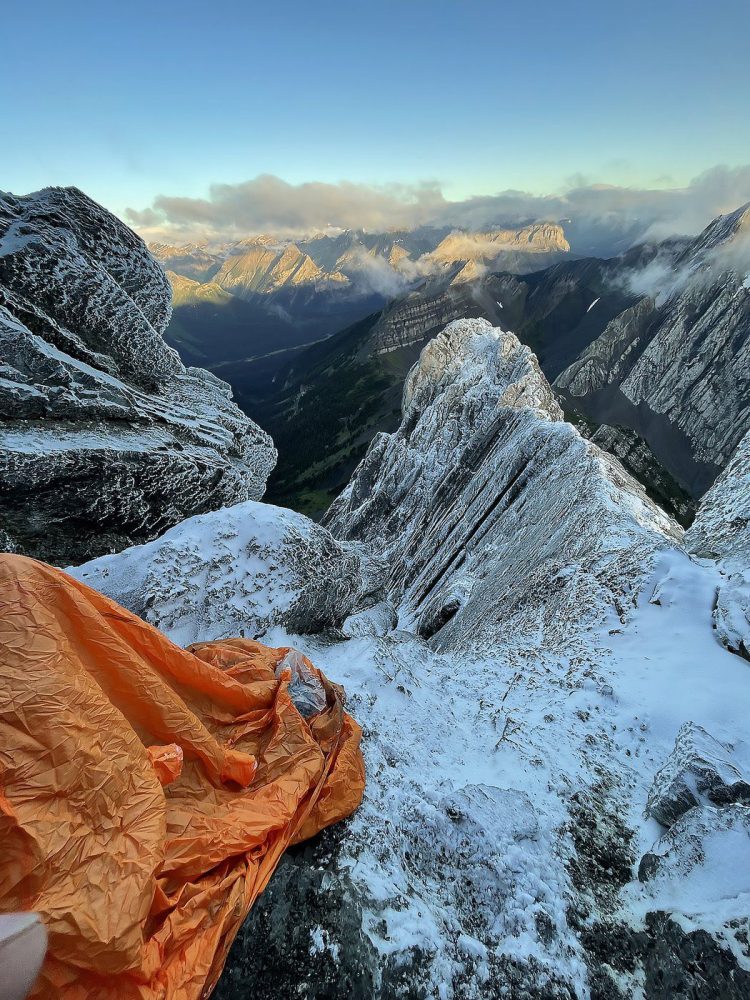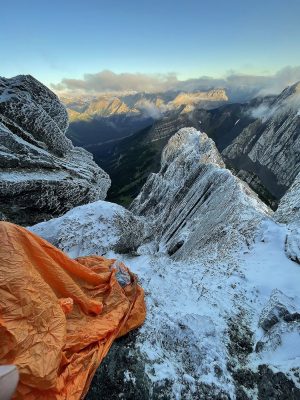Stranded climbers spend two freezing nights on Kananaskis mountain
By Jessica Lee, Local Journalism Initiative Reporter
A group of climbers spent two chilly nights at about 9,500 feet on the northwest face of Mount Birdwood in Kananaskis Country over the weekend after their rope became stuck on descent.
The two climbers began their trek Friday (Aug. 23) and summitted the peak in Spray Valley Provincial Park but were forced to spend that night on the side of the mountain with just the clothes on their backs.
“They were rappelling and during the rappel, their ropes became stuck. It was also getting fairly late at the time, so it was fairly dark, and the group just made the decision to sit tight,” said Kananaskis Mountain Rescue specialist Mike Koppang.
Bad weather had also started to roll in overhead in the form of rain, lightning, extreme winds, as well as snow and freezing temperatures.
In nearby Bow Valley Provincial Park, the closest weather station located at a much lower 4,200 feet recorded 6.4 millimetres of precipitation and wind speeds up to 20 km/h overnight – felt more severely in higher, exposed terrain.
“That was a fairly intense storm and left them quite cold, with a bit of snow on them, and fairly strong winds,” said Koppang, who responded to the incident with a rescue team the following day.
Kananaskis Mountain Rescue was alerted via a satellite device and the climbers fortunately had one bar of cell service high up on the mountain to also notify friends of exactly what happened.
A response that was initiated Saturday morning (Aug. 24) with assistance from Alpine Helicopters was hindered by cloud cover and wind.
“We couldn’t see where the people were, but we knew what area they were in based on a GPS location off their phone,” said Koppang. “We weren’t able to access them and because of the winds, we weren’t able to land close.”
What was a planned rescue via heli-sling quickly changed to a climb.
Koppang and another rescuer were dropped in over the Burstall Pass region.
“We were able to ascend the ridge through technical terrain to reach the people that were still on their rope,” he said. “That happened at about 4 o’clock with fairly strong winds and light snow while we were climbing.”
The two climbers were lowered to a bigger ledge and treated for exposure from spending the night mostly unprotected from the elements.
“They were tired, but it was becoming clear we weren’t going to make it off the mountain that night, so we decided to shelter in place for the evening in a bothy bag,” said Koppang.
A bothy bag is a portable emergency shelter used in hikes and mountain expeditions to provide protection against the elements.
“We did have a fairly good shelter that was able to get all four of us inside, and everyone sat on their backpacks. We had enough clothes to keep ourselves warm and extra clothes to give to the other people to get them to a more adequate temperature. But, bottom line, it’s not pleasant,” said Koppang of spending the night mountainside in harsh conditions.
“You’re sitting on a backpack under a tarp in very significant winds and it’s loud. You don’t really get much sleep. You kind of go through all the different stories you can and then some of them, you go through two or three times just to keep yourself entertained … You just kind of work together as a group to make the night go as quickly as you can.”
The next morning, the group was transported off the ridge via heli-sling and back towards Burstall Pass, where they were able to enter the aircraft and then dropped off at the Burstall Pass parking lot.
The two climbers were subsequently checked over by Alberta Health Services EMS.
Koppang said the incident serves as a reminder to always prepare for something to go wrong when out in the mountains. This includes bringing adequate equipment, including warm clothing, a satellite communication device, and checking the weather forecast.
He said it’s also important to ensure an objective – be it a hike, scramble, climb, or anything else – is within your skill level. And if the weather turns or conditions change, turn around.
“There are tons of different ways we can get into the mountains and enjoy them. So that’s kind of the big takeaway there – the mountains are going to be there for a long time. Don’t be scared to turn around and leave that mountain for another day. If you don’t think you’re gonna be able to get down safely or you see a bad storm coming, it’ll always be there the next day.”

PHOTO COURTESY OF KANANASKIS MOUNTAIN RESCUE

